ROUTE OF THE MAYA
November 9 - 26, 2010
Page Fourteen
Belize - Lamanai
Belize, formerly British Honduras, is a democratic constitutional monarchy, and the northernmost Central American nation. Belize has a diverse society, comprising many cultures and languages. Although Creole and Spanish are spoken among the population, Belize is the only country in Central America where English is the official language. Belize is bordered to the north by Mexico, south and west by Guatemala, and to the east by the Caribbean Sea. Belize’s mainland is about 180 miles long and 68 miles wide. With 8,867 square miles of land and a population of only 333,200 people, Belize has the lowest population density in Central America. The country's population growth rate of 2.21% is the highest in the region. Belize is culturally unique among its Central American neighbors; it is the only nation in the region with a British colonial history. Before the arrival of Europeans, the Mayan civilization spread itself over Belize beginning around 1500 BC and flourished until about 800 AD. Spanish colonists tried to settle the inland areas of Belize, but Maya rebellions and attacks forced them to abandon these efforts. English and Scottish buccaneers first settled on the coast of Belize in 1638, seeking a sheltered region from which they could attack Spanish ships. The British first appointed a superintendent over the Belize area in 1786. Prior to that time, the British government did not initially recognize the settlement in Belize as a colony for fear of provoking Spanish attack. The Spanish repeatedly tried to gain control over Belize by force, but were unsuccessful. Spain's last effort occurred on September 10, 1798, when the British repelled the Spanish fleet in a short engagement, known as the Battle of St. George's Caye. The battle took place between an invading force from what would become Mexico, attempting to wrest Belize for Spain, and a small force of resident woodcutters called Baymen, who fought for their livelihood assisted by Black slaves. The anniversary of the battle is now a national holiday in Belize. Constitutional reforms were initiated in 1954 and resulted in a new constitution ten years later. Britain granted British Honduras self-government in 1964. British Honduras was officially renamed Belize in 1973. Progress toward independence was hampered by a Guatemalan claim to sovereignty over the territory of Belize. When Belize finally attained full independence on September 21, 1981, Guatemala refused to recognize the new nation. Throughout Belize's history, Guatemala has claimed ownership of all or part of the territory. This claim is occasionally reflected in maps showing Belize as Guatemala's twenty-third department (state). The border dispute with Guatemala remains unresolved. Guatemala's claim to Belizean territory rests, in part, on the terms Clause VII of the Anglo-Guatemalan Treaty of 1859 which (supposedly) obligated the British to build a road between Belize City and Guatemala. At various times the issue has required mediation by the United Kingdom, Caribbean heads of Government, the Organization of American States, Mexico, and the United States. Since independence, a British garrison has been retained in Belize at the request of the Belizean government. Belize has a small, essentially private enterprise economy that is based primarily on agriculture, agro-based industry, and merchandising, with tourism and construction recently assuming greater importance. Sugar, the chief crop, accounts for nearly half of exports, while the banana industry is the country's largest employer.
Lamanai (means submerged crocodile) is an archaeological site once a considerably sized city of the Maya civilization, located in the north of Belize. Lamanai was occupied as early as the 16th century BC. The site became a prominent center in the Pre-Classic Mayan Period, from the 4th century BC through the 1st century AD. In 625 AD. Lamanai continued to be occupied up to the 17th century AD. During the Spanish conquest of Yucatan, Spanish friars established two Roman Catholic churches here, but a Maya revolt drove the Spanish out. The site was subsequently incorporated by the British in British Honduras, passing with that colony's independence to Belize. The vast majority of the site remained unexcavated until the mid-1970s. Archaeological work has concentrated on the investigation and restoration of the larger structures, most notably the Mask Temple, the Temple of the Jaguar Masks, and the High Temple. The summit of this latter structure offers a view across the surrounding jungle to a nearby lagoon, part of the New River.
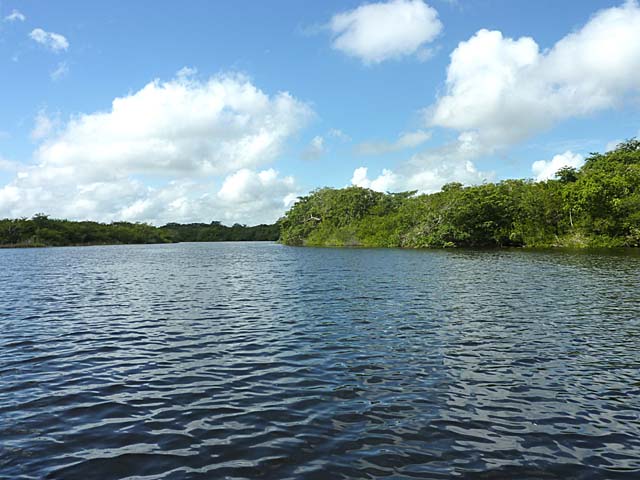
We took a guided river trip on the New River to access the Mayan site of Lamanai, the only
way to get to Lamanai. It was a beautiful day when we started out on the river, but we got
caught in a windy rainstorm before we reached Lamanai. Fortunately, the rain stopped
once we got there, though it remained overcast for a while.
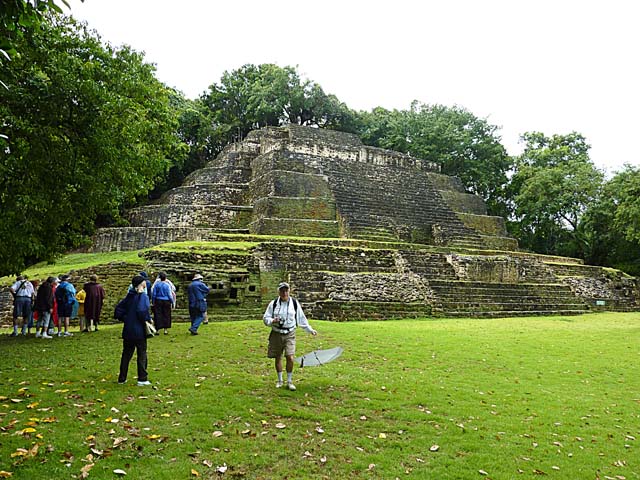
Temple of the Jaguar Masks at Lamanai
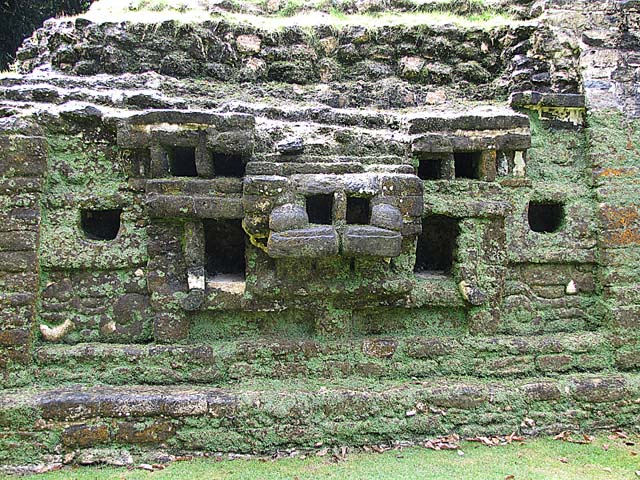
One of the Jaguar Masks
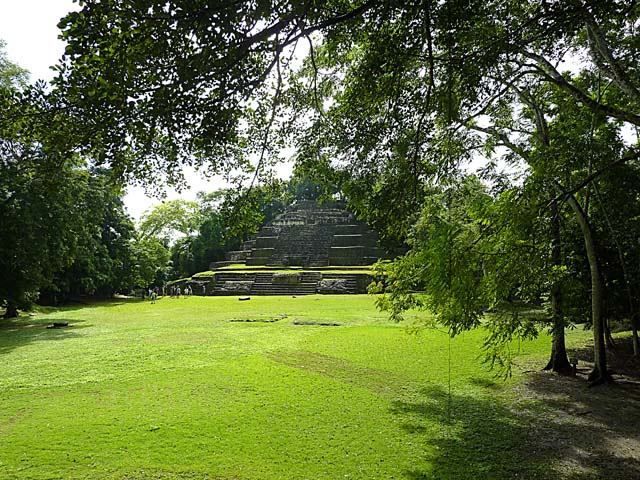
Distant view of the Temple of Jaguar Masks
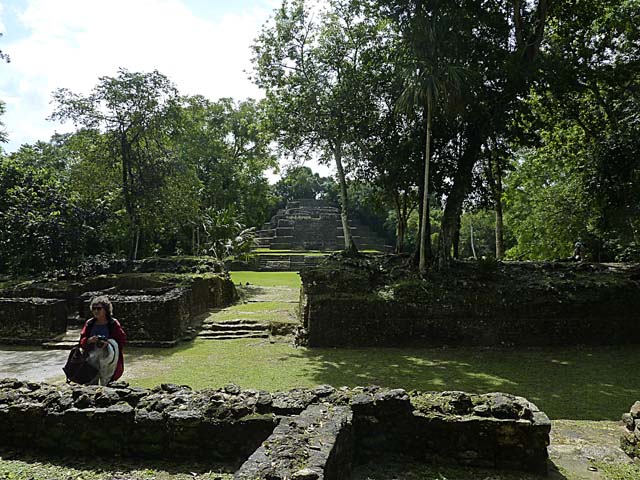
The Royal Complex at Lamanai with Temple of the Jaguar Masks in the background.
The Royal Complex was used by the Maya elite as residences.
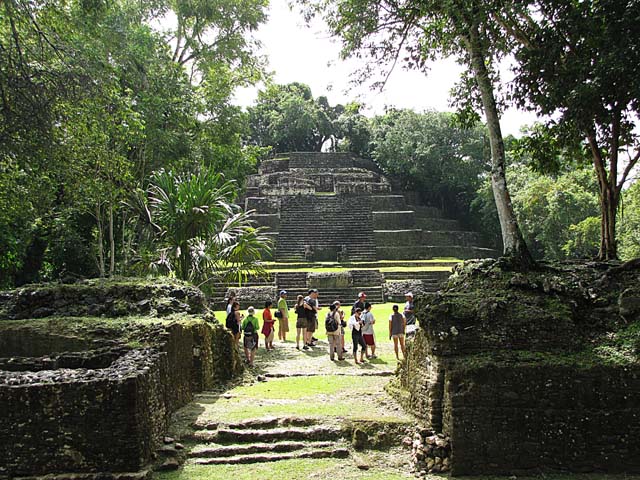
Another view from the residential area
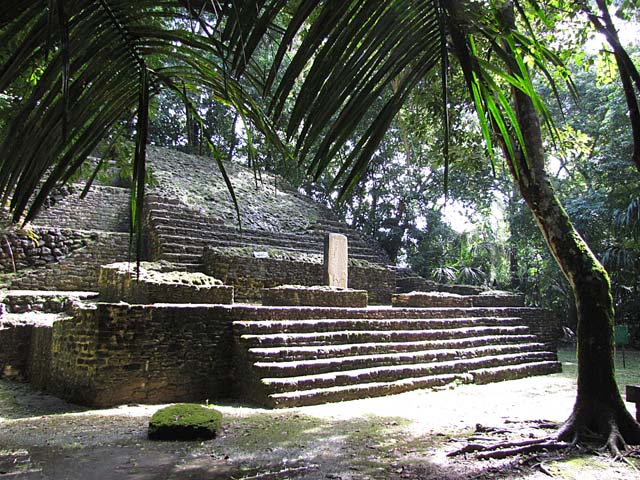
Stela in front of another step pyramid in the midst of the forest.
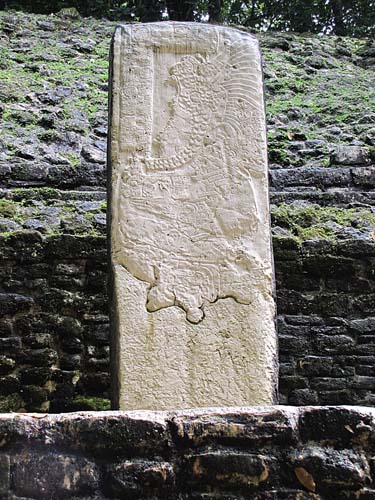
Stela 9 shown here depicts Lord "Smoking Shell" holding a double headed
ceremonial bar diagonally across his chest. The headdress has typical traits
of the
Early
Classic Mayan period.
At the base of the Stela, the remains
of 5 children were found.
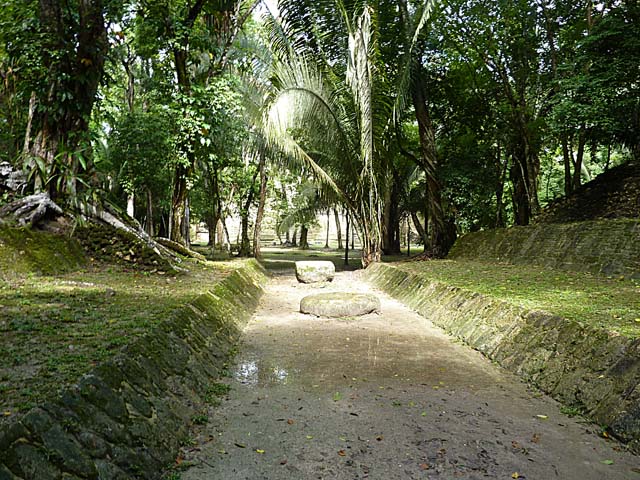
Ballcourt at Lamanai
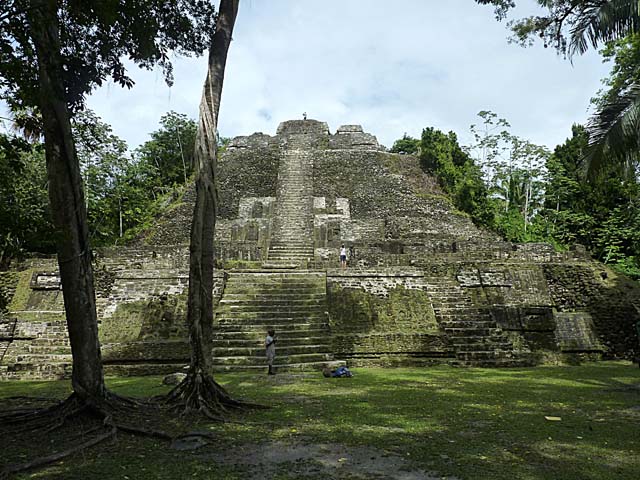
The High Temple from which you can see the New River and surrounding jungle.
It is about 108 feet high and is the tallest structure at Lamanai. Initial construction
was begun in 100 BC.
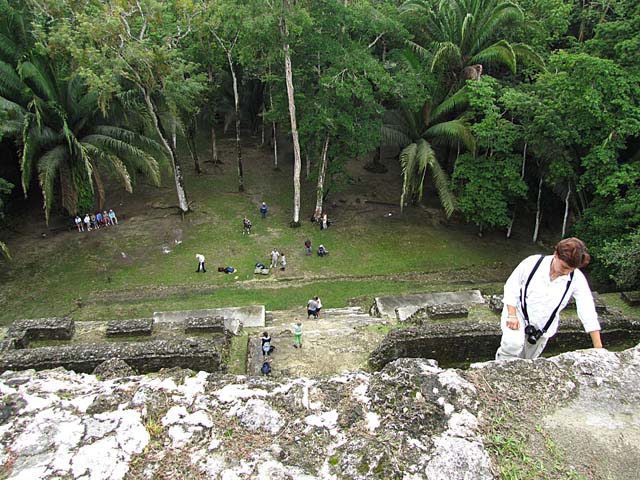
Climbing the High Temple
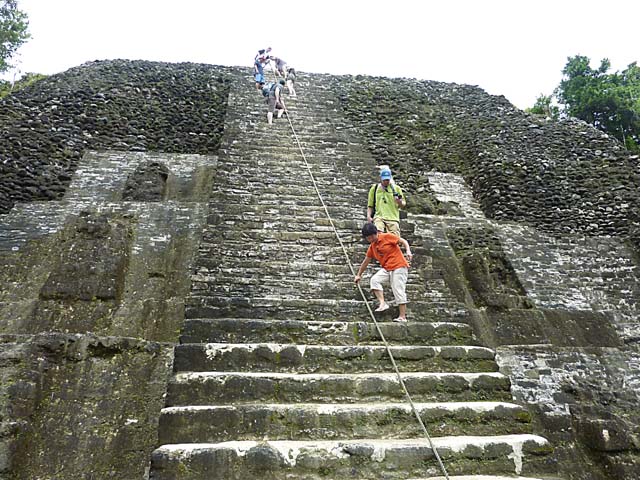
The top portion of the High Temple has a cable to help tourists negotiate the final
section, due to the uneven, steep, and crumbling steps.
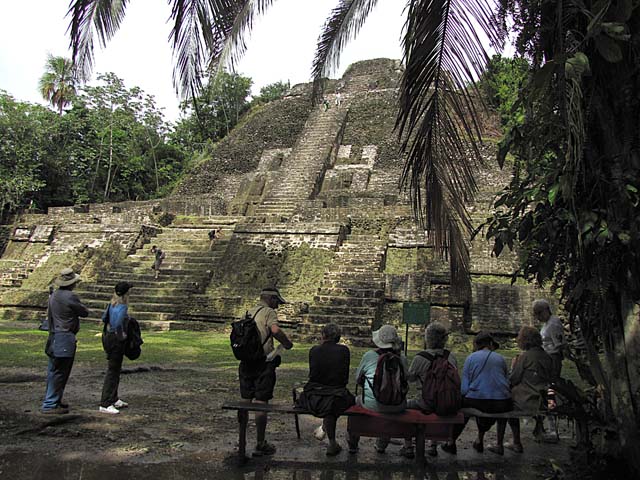
View of the High Temple from the bottom. One member of our group slipped and
fell near the bottom steps, banging her head, arms, and legs on the steps. Fortunately,
she was not seriously hurt.
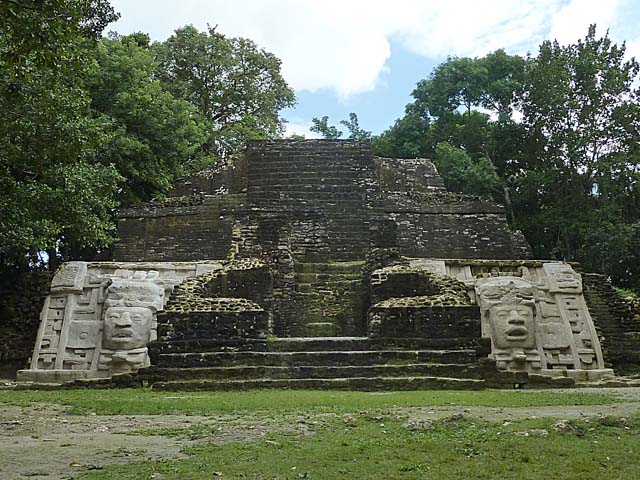
The Mask Temple at Lamanai. The masks have been restored.
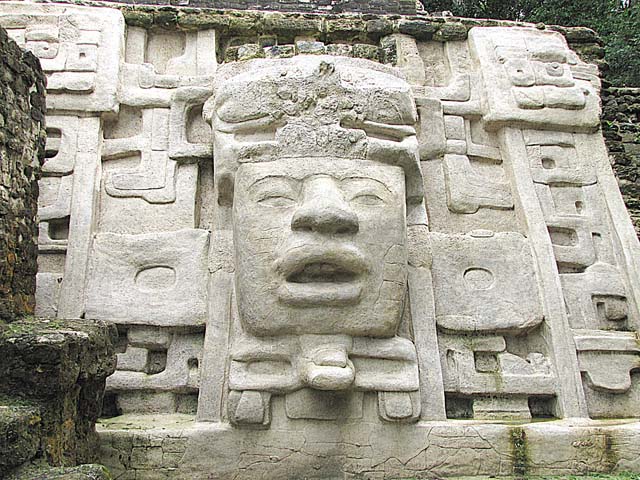
Closeup view of one of the masks
Link to Page 15 - Belize continued
Link to Page One of Route of the Maya
Pat's Home Page